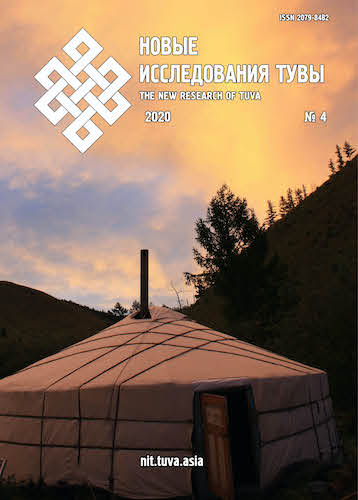Tuvan traditional methods of precise computation in the making of yurt frame
DOI:
https://doi.org/10.25178/nit.2020.4.5Keywords:
Yurt; yurt building; yurt making; nomadic house; Tuvans; traditional technology; kharaacha; Tuvan yurt; Tuvan cultureAbstract
The article examines methods of computation used by Tuvan craftsmen in making the Tuvan yurt frame, in particular its upper circle known as “kharaacha”.
These methods provided reliability and durability of the structures and the yurt’s unusual feature of changing size and configuration according to a specific season. Traditional Tuvan house is thus adaptable to various natural and climatic conditions and phenomena. It was especially important to maintain the precalculated parameters in making grooves in kharaacha (upper circle), into which the upper ends of ulun (ynaa, rafters of the yurt) were inserted.
The article gives details of computation methods, measurements, and the process of preparing, drilling, and improving the configuration of kharaacha grooves during their making. It also shows plans and drafts of traditional calculation methods, measurements, and devices.
References
Baiyr-ool, M. S. (2013) Iurta v tuvinskoi traditsionnoi kul'ture [The yurt in traditional Tuvan culture]. New Research of Tuva, no. 2, pp. 67–79 [online] Available at: https://nit.tuva.asia/nit/article/view/242 (access date: 01.07.2020).
Bokhoeva, L. A. and Baldanov, A. B. (2013) Komp'iuternoe modelirovanie karkasa iurty s primeneniem kompozitsionnykh materialov [Computer modeling of the yurt’s frame using composite materials]. Vestnik VSGUTU, no. 4 (43), pp. 35–38.
Vainshtein, S. I. (1991) Mir kochevnikov tsentra Azii [The world of nomads of the center of Asia]. Moscow, Nauka. 296 p. (In Russ.).
Kan-ool, M. A. and Ondar, A. B. (2014) Iurta: predmety byta tuvintsev [The yurt: everyday objects of Tuvans]. In: Aktual'nye problemy issledovaniia etnoekologicheskikh i etnokul'turnykh traditsii narodov Saiano-Altaia [Urgent issues of researching ethnoecological and ethno-cultural traditions of the Sayano-Altai peoples]: Proceedings of the 2nd International conference of young scientists, postgraduates and students. 100th anniversary of the unity of Russia and Tuva and in the framework of the implementing the program for the development of student associations / ed. by O. M. Khomushku. Kyzyl, TuvGU; KhGU im. N. F. Katanova. 155 p. Pp. 73–74.
Kokova, E. A. and Tolmashov, A. G. (2014) Khakasskaia iurta v kontekste etnomatematicheskikh idei [Khakass yurt in the context of ethnomathematical ideas]. In: Aktual'nye problemy issledovaniia etnoekologicheskikh i etnokul'turnykh traditsii narodov Saiano-Altaia [Urgent issues of researching ethnoecological and ethno-cultural traditions of the Sayano-Altai peoples]: Proceedings of the 2nd International conference of young scientists, postgraduates and students. 100th anniversary of the unity of Russia and Tuva and in the framework of the implementing the program for the development of student associations / ed. by O. M. Khomushku. Kyzyl, TuvGU; KhGU im. N. F. Katanova. 155 p. P. 20.
Maidar, D. and Piurveev, D. B. (1980) Ot kochevoi do mobil'noi arkhitektury [From nomadic to mobile architecture]. Moscow, Stroiizdat. 215 p.
Nikiforov, S. O., Mikhailov, V. N. and Nikiforov, B. S. (2014) Osobennosti dizaina mongol'skikh iurt (GER)O: genezis, tipologiia, karkasno-modul'nye tekhnologii i ikh transformatsiia [Design features of Mongolian yurts (GER)O: Genesis, typology, frame-modular technologies and their transformation]. Vestnik Buriatskogo nauchnogo tsentra SO RAN, no. 1 (13), pp. 99–116.
Ulturgasheva, O. G. and Tinikova, Yu. K. (2013) Iurta — khranitel'nitsa traditsionnykh obriadov kochevykh narodov Azii (na primere khakasskoi iurty) [The yurt as a keeper of traditional rites of nomadic peoples of Asia: the case of the Khakass yurt)]. Vestnik KemGUKI, no. 22, pp. 52–59.
Published
How to Cite
Ооржак В. О. Тувинские традиционные методы точных расчетов при изготовлении каркаса юрт // Новые исследования Тувы. 2020, № 4. С. 64–79. DOI: www.doi.org/10.25178/nit.2020.4.5
For citation:
Oorzhak V. O. Tuvinskie traditsionnye metody tochnykh raschetov pri izgotovlenii karkasa iurt [Tuvan traditional methods of precise computation in the making of yurt frame]. New Research of Tuva, 2020, no. 4, pp. 64–79. (In Russ.). DOI: www.doi.org/10.25178/nit.2020.4.5
Issue
Section

This work is licensed under a Creative Commons Attribution-NonCommercial 4.0 International License.

Author(s) license holder(s) grant rights for their work to the journal (grantee of a license) under the simple non-exclusive open license in accordance with Art. 1286.1 «Open license for a research work, work of literature or fine arts», Civil Code of the Russian Federation.
New Research of Tuva publishes articles under the Creative Commons Attribution-NonCommercial license (CC BY-NC).
Since it is an open license, author(s) reserve the right to upload the article to their institutional repository, submit it to another journal (if it allows republications), or republish it on their own website (in full, or in part).
However, several conditions apply here:
a) The republished version must always contain the name(s) and affiliation(s) of the author(s), the original title and the hyperlink to the original version on the New Research of Tuva website;
b) It must be in open access, free of charge, and no category of readers must be in any way whatsoever advantaged over general readership.
c) should the contribution be submitted elsewhere by its author(s) without substantial modification (30% or more of original text unchanged), the body of the article should contain a disclaimer that the original version was published in New Research of Tuva (with a link to the respective page)
The CC-BY-NC is a non-revocable license which applies worldwide and lasts for the duration of the work’s copyright.








